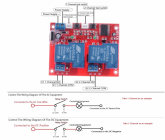MisterSandals
Participation Medalist
I am hoping someone can help me find a solution. I am learning about relays and hoping to incorporate one to cut the power between my array and solar charge controller. 400w array, 45A SCC.
My "thought" was to use an NO (normally open) relay but wondering how i would power a "close" in the event of a BMS cutoff or other loss of battery power (goal: stop power to the SCC). With a power loss (or a BMS cutting power), it seems i cannot close the relay - doh!
So if I were to use an NC (normally closed) relay, I would need to power it "open" 24/7/365 using at least an amp of power. And I am guessing holding the switch open all the time, would shorten the life of the relay significantly.
Is there something other than a relay I should consider?
My "thought" was to use an NO (normally open) relay but wondering how i would power a "close" in the event of a BMS cutoff or other loss of battery power (goal: stop power to the SCC). With a power loss (or a BMS cutting power), it seems i cannot close the relay - doh!
So if I were to use an NC (normally closed) relay, I would need to power it "open" 24/7/365 using at least an amp of power. And I am guessing holding the switch open all the time, would shorten the life of the relay significantly.
Is there something other than a relay I should consider?







